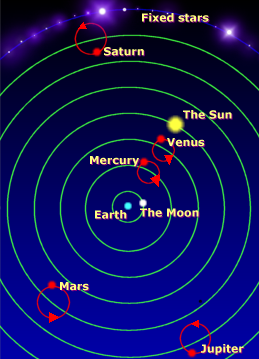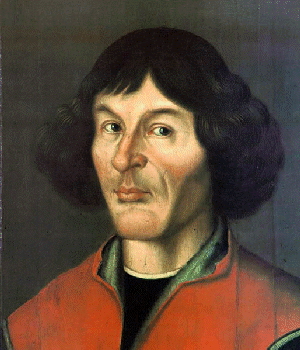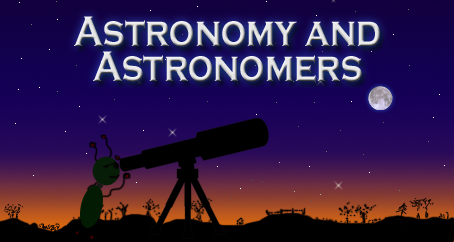Astronomy: The Scientific Age

If you were able to go about 500 years back in time and asked somebody to describe the Universe, the response you would get would be very different to the response you would get if you were to ask somebody the same question today. Back then, people believed that Earth was at the centre of the Universe. Spinning around it were the Moon, the Sun and five planets: Mercury, Venus, Mars, Jupiter and Saturn. At a greater distance were the stars, orbiting at a fixed point beyond the orbit of Saturn. To explain the sometimes strange movement of the planets (they sometimes appear to go backwards), it was believed that they orbited Earth in circles known as epicircles. The diagram to the left shows what people believed the Universe to look like hundreds of years ago. At that time, people also didn't know that the planets Uranus and Neptune existed. They didn't know about the Asteroid Belt in between Mars and Jupiter, or the existence of small worlds like Ceres and Pluto. They also didn't know that other planets had moons orbiting them. Comets, strange objects which appeared to make random appearances, were a mystery and were often seen as a sign that a notable event was going to occur.
This old model of the Universe had been believed to be correct for hundreds of years. It appeared to make sense and most people had no reason to question it. However, to some people, certain things didn't add up. Mainly, the way planets orbited, even though the "epicircle" explanation suited most curious minds, still didn't make sense. Nicolaus Copernicus (1473 - 1543), a Polish mathematician and astronomer, was one such person who was puzzled by the way the Universe looked. His simple solution was to put the Sun at the centre of everything, and not Earth. He believed that Earth was actually a planet like the other five, orbiting the Sun. The only object to orbit Earth was the Moon. The idea of a sun-centred system, or a solar system, had been proposed by Muslim astronomers many years earlier, but never really followed up. Copernicus spent years studying the planets, and put down his ideas in the book De Revolutionibus Orbium Coelestium (On the Revolutions of the Heavenly Spheres). However, he refused to publish this book until he knew it was completely right. Another reason for delaying its publication was because he probably knew the chaos it would cause. Not only would it be difficult to tell everybody that everything they have believed to be true for hundreds of years is actually wrong, it would offend many people, most notably other scientists and religious leaders. With both groups of people, by putting the Sun at the centre of the Solar System, Copernicus was contradicting what they taught. In Copernicus' time, the Catholic Church was extremely powerful in Europe. The model of the Universe that had been believed for hundreds of years fitted in well with the teachings of the Church. The celestial objects (the Moon, the Sun and the planets) were all perfectly formed spheres that travelled in perfectly circular orbits around a perfectly formed Earth. This perfect system could only have been created by God, so claiming that it was wrong could be seen as questioning the teachings of the Bible and only a brave (or stupid) person would have done that. Copernicus' book was finally published in 1543. It is rumoured that the first copy was presented to him on his death bed and that he witnessed the publication of his life's work just before dying.

Despite its publication, Copernicus' book didn't initially really have much of an effect on the minds of most people. However, another great astronomer was about to make his mark, and it is Copernicus' theories that he tried to prove. Galileo Galilei (1564 - 1642) was an Italian astronomer who was one of the first to take advantage of the technology of the time. The telescope was a new Dutch invention from 1608 which could be used to look further into space. Previous to the telescope, the universe was viewed with the naked eye. Galilei built his first telescope in 1609 and with it - and other telescopes he built later in his life - he was able to look closer at the objects in the sky. He made several discoveries which contradicted both religious and scientific teachings and backed up Copernicus' theory of a Sun-centred system. Below are some of Galilei's main discoveries, and what their discoveries implied:
- The Moon has craters and mountains. Religious leaders taught that the
Moon was a perfectly formed sphere. The fact it had craters and mountains meant that it wasn't perfect.
- Galilei discovered four moons orbiting Jupiter:
Io, Europa,
Ganymede and Callisto. At the time, people were taught that
everything orbited Earth, so the fact that
Jupiter had objects orbiting it would oppose this idea. Copernicus had earlier claimed that
Earth was just a planet orbiting the Sun. As
Earth has its own satellite (the Moon), it would make sense that other planets orbiting the same
Sun would also have satellites. The discovery of
Jupiter's moons therefore backed up Copernicus' theories that the
Sun is at the centre of the known universe.
- Galilei observed the phases of Venus. Although it was expected that
Venus would have phases, the phases that Galilei observed backed up the idea that
Venus orbited the Sun and not
Earth. It was this discovery that eventually led people to accept that the planets do orbit the
Sun and not Earth.
- Galilei observed Saturn, discovering its rings. He noticed that on different occasions the rings appeared to vanish (when they were viewed side-on from
Earth) and reappeared, which confused him, but added more evidence that the objects in space are more complex than previously believed.
The vanishing and reappearing of the rings was due to the fact that their tilt
changes over a period of time.
- Galilei observed sunspots. Like the
Moon, the Sun was believed to be a perfect sphere.
Sunspots would be seen as an imperfection and again conflicted with the idea of a perfectly-formed universe.
Something that must be noted is that neither Copernicus or Galilei set out to oppose religious beliefs. They were both deeply religious people and were careful to emphasise that what they had discovered and were proposing was not a dismissal of their faith. However, not everybody accepted this. Copernicus' book was banned and many scientists and philosophers simply refused to believe that Galilei had made the discoveries that he claimed to have made. Galilei was put on trial in 1632 at the Holy Office in Rome and was found guilty of heresy. He was placed under house arrest and spent the rest of his life restricted in want he could say and do.
As time went by and more and more astronomers used telescopes to look into the night skies, the evidence began to pile up that the Sun, not Earth, had to be at the centre of the Solar System. Saturn's largest moon Titan was discovered in 1655 by Dutch astronomer Christiaan Huygens, with more moons of Saturn getting discovered later in the century. Scientific evidence began to overrule religious teachings, and it gradually became accepted that the universe was much more complex (and interesting!) than previously imagined. Maps of the Moon were created, polar regions on Mars were observed, and the Great Red Spot on Jupiter was first spotted. Copernicus' book was eventually removed from the Vatican's list of banned books in 1758.
As telescopes became more powerful and were able to look even deeper into space, new worlds were discovered to be present in the Solar System. The first of these worlds, and therefore the first planet to have ever been discovered, was Uranus. It was found in 1781 by English astronomer, Sir William Herschel. He also found two of Uranus' moons in 1787 (Titania and Oberon, which were named in 1852 by his son, John Herschel, in addition to the moons Ariel and Umbriel, found in 1851 by William Lassell, another English astronomer). The presence of Uranus led people to believe that there may be even more planets in the Solar System. Ceres was found in the region now known as the Asteroid Belt (between Mars and Jupiter) in 1801 by Italian astonomer Guiseppe Piazzi. He originally thought he had found a comet, but its movement suggested otherwise. Ceres was originally classified as a planet, but was reclassified as an asteroid when several other similar objects were found in the same region. It was again reclassified as a dwarf planet in 2006. Astronomers observing Uranus noticed there was something strange about its orbit, as if something was pulling it outwards. The kind of effect could be caused by the gravity of a planet even more distant than Uranus. Mathematicians got to work doing maths and predicted the location of this planet. It was eventually spotted in 1846 by German astronomer Johann Gotfried Galle and became known as Neptune. Shortly afterwards, William Lassell observed a moon orbiting Neptune, which became known as Triton. Although Galle is credited as the discoverer of Neptune, Galileo Galilei actually spotted the planet over two hundred years earlier, but recorded it as a dim star!
Towards the end of the nineteenth century, astronomers used their telescopes to look closer at one of Earth's neighbours - Mars. Although the red planet had been observed for thousands of years, it was at this time that astronomers were able to look closer at the planet and to try to learn more about what the planet is actually like. They were able to observe Mars' polar regions, noticing that the area taken up by them changed in size depending on the season. They observed what they thought was vegetation on the planet. Some astronomers also claimed to have observed canals on Mars, believing them to have been built by civilised beings to transport water from the poles to dryer regions of the planet. The fact that Mars appeared quite Earth-like and seemed to have artificially created structures led to many people accepting that there is life on the planet. Inspired by this, authors began to write science fiction books with one of the most famous early examples being The War of the Worlds by H.G. Wells which told of an invasion of Earth by the Martians.
The modern era of astronomy began in the twentieth century. Photography, electricity, rocket power and satellite technology would go on to change the way people observed the Universe forever, enabling them to make even more discoveries and uncover more mysteries about the many objects in space.
